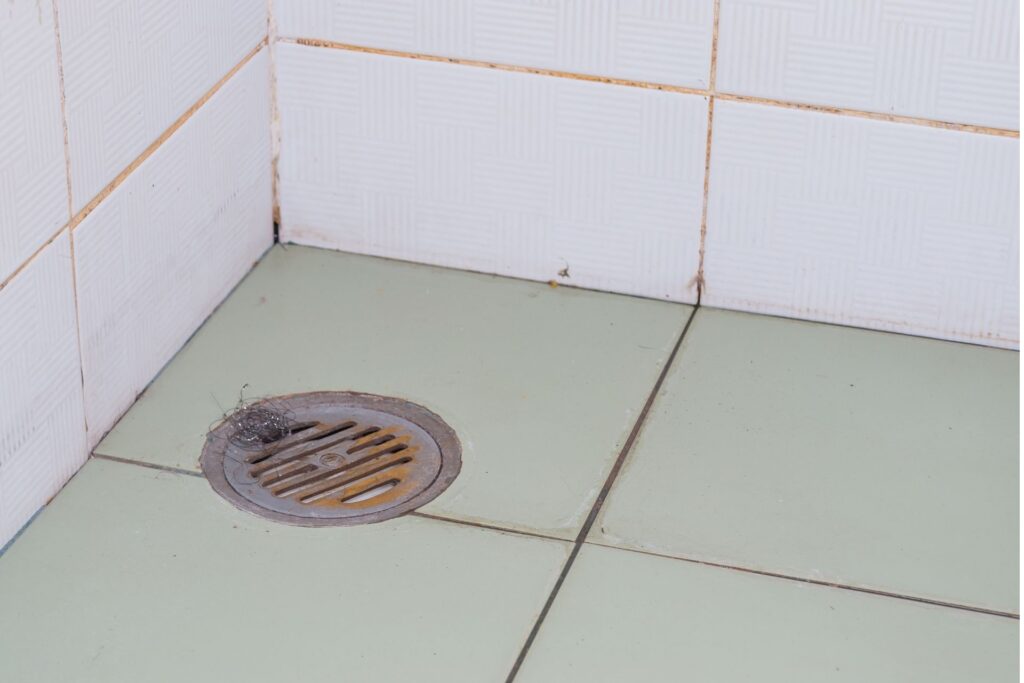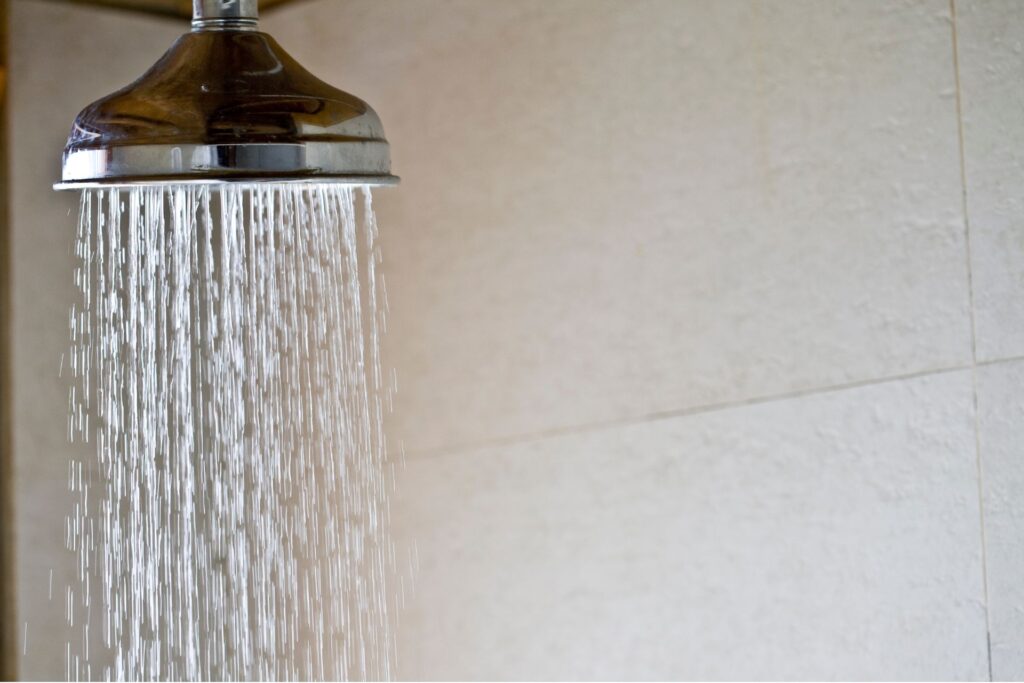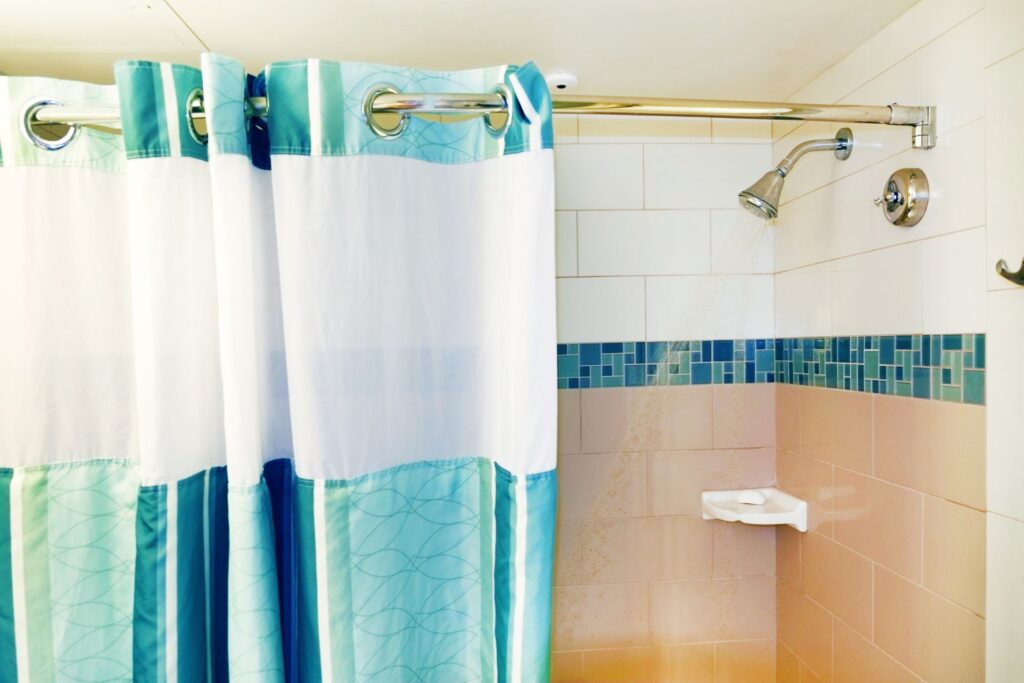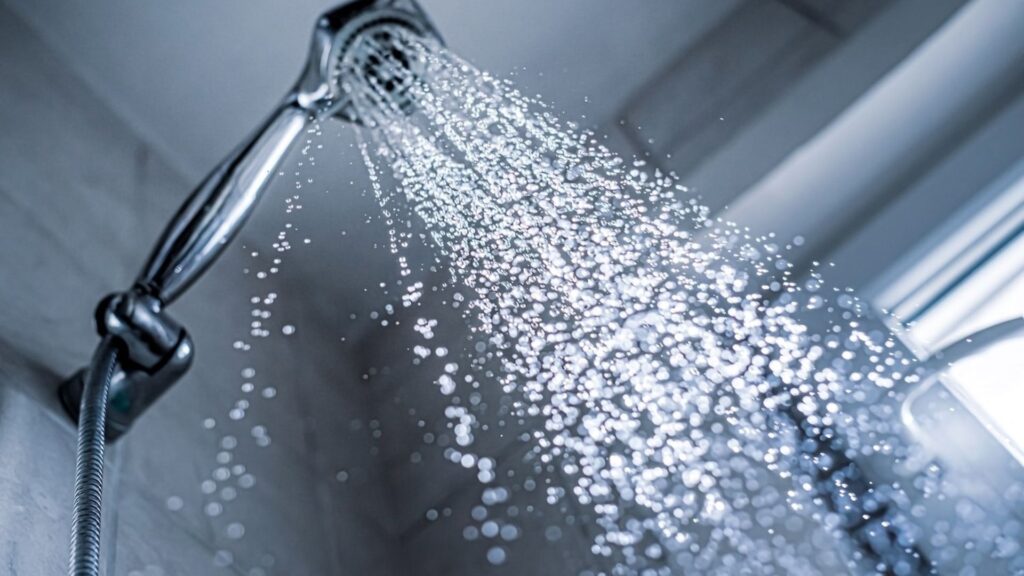Welcome to your ultimate guide on how to unblock a shower drain—a common household nuisance that can turn your daily routine into a frustrating ordeal. We’ve all been there, standing in an unexpected puddle, wondering where things went wrong. It’s not just about inconvenience; a clogged drain can signal underlying plumbing issues that might worsen over time. But fear not! In this post, we’ll walk you through several practical, tried-and-tested methods to get that water flowing smoothly again. From natural solutions to mechanical interventions, we’re here to arm you with the knowledge you need to tackle the problem head-on, ensuring you’re prepared for this and any future drain dilemmas with confidence and ease.
To quickly unblock a shower drain, start by removing visible debris. Next, pour a mixture of 1 cup of baking soda followed by 1 cup of vinegar down the drain and let it sit for 10-15 minutes to break down the clog. Flush with boiling water to clear the residue. For stubborn clogs, use a plunger or a plumber’s snake. Regular maintenance, like using a drain protector and periodic cleaning with natural substances, can prevent future blockages.
- Understanding Your Shower Drain
- The Importance Of Regular Maintenance
- Preparing To Unclog Your Shower Drain
- Step-By-Step Guide To Unclogging Your Shower Drain
- Preventing Future Clogs
- The Environmental Impact Of Drain Cleaners
- FAQs: About How To Unblock Shower Drain
- Conclusion
- Find A Professional Plumbing Company Near You
Understanding Your Shower Drain
When it comes to home maintenance, one of the most overlooked aspects is the shower drain. Yet, it plays a pivotal role in keeping your bathroom clean and functional. In this comprehensive guide, we’ll dive deep into understanding your shower drain, covering everything from the types you might find in your home to the reasons they can become clogged. Our aim is to provide you with practical insights and tips to ensure your shower remains a place of relaxation and cleanliness.
Quick Overview of Common Types of Shower Drains
Shower drains come in various shapes and sizes, each designed to fit specific needs and shower setups. Let’s explore the most common types you’re likely to encounter:
1. Point Drains: These are the traditional drains located at the shower floor’s center. They work well in collecting water from all directions, thanks to their central positioning.
2. Linear Drains: A more modern option, linear drains stretch across a section of the shower floor, offering a sleek and contemporary look. They are especially effective in showers with large tiles, as they require fewer cuts.
3. Tile-insert Drains: These drains allow for a cohesive look by letting you insert a piece of tile into the drain itself. This camouflages the drain, making it almost invisible against the shower floor.
Each type of drain has its installation specifics and aesthetic appeal, catering to different bathroom designs and functionalities.
Reasons Why Shower Drains Get Clogged
Understanding the common culprits behind clogged shower drains can help you prevent the issue before it escalates. Here are the main reasons why blockages occur:
Hair: Probably the most common cause, hair binds together and forms a net, trapping other debris and gradually building up to a blockage.
Soap Scum: Soap residue combines with minerals in water to form a hard, sticky substance that clings to the sides of the drain, narrowing the passage for water to flow through.
Hard Water Deposits: Homes with hard water may experience a buildup of minerals that can accumulate in the drain, further restricting water flow.
Foreign Objects: Small objects, such as bottle caps, small toys, or chunks of soap, can accidentally fall into the drain and cause obstructions.
Knowing the types of shower drains and understanding what causes clogs can help you take preventive measures to maintain a clear and fully functional shower drain. Regular cleaning, using drain guards to catch hair, and avoiding the disposal of inappropriate items down the drain can save you from the hassle and expense of dealing with clogs. Stay informed and proactive about your bathroom maintenance to ensure your shower remains a welcoming space for relaxation and cleanliness.

The Importance Of Regular Maintenance
In the realm of home maintenance, the importance of regular upkeep cannot be overstated, particularly when it comes to your plumbing system. Regular cleaning and maintenance play pivotal roles in preventing clogs, ensuring the longevity of your plumbing infrastructure, and maintaining hygiene within your home. This section delves into the significance of these practices and the benefits they bring to your household.
Why Regular Cleaning is Essential to Prevent Clogs
Clogs are more than just minor inconveniences; they are potential disasters waiting to happen. Over time, debris such as hair, food particles, grease, and soap can build up inside your pipes. If not addressed, these can lead to significant blockages that not only disrupt your daily life but can also result in costly repairs. Regular cleaning, therefore, is not merely a recommendation; it’s a necessity.
The process of keeping your drains clear involves several straightforward yet effective practices. For instance, routinely using a drain strainer can prevent larger particles from entering your plumbing system. Additionally, regular flushing of the pipes with hot water can help dissolve any build-up of oils and fats that may lead to blockages. Incorporating these simple steps into your cleaning routine can significantly reduce the risk of clogs.
The Benefits of Plumbing Health and Hygiene
The state of your plumbing system is intrinsically linked to the overall hygiene of your home. A well-maintained plumbing system ensures the efficient removal of waste and the provision of clean water, which are fundamental to maintaining a healthy living environment. Regular maintenance not only helps prevent the development of foul odors caused by blockages but also mitigates the risk of bacteria and mold growth, which can have adverse effects on your health.
Furthermore, the health of your plumbing system directly impacts its longevity and efficiency. By preventing clogs and other issues through regular maintenance, you can avoid the stress and expense of emergency repairs. This proactive approach not only saves money in the long run but also contributes to the sustainable management of your home’s resources.
In conclusion, the importance of regular maintenance in preventing plumbing clogs and ensuring the health and hygiene of your home cannot be overstated. Adopting simple cleaning practices can lead to significant benefits, including the prevention of blockages, the extension of your plumbing system’s lifespan, and the maintenance of a healthy living environment. As homeowners, it’s crucial to recognize the value of these maintenance practices and integrate them into our routine to safeguard our homes and well-being.
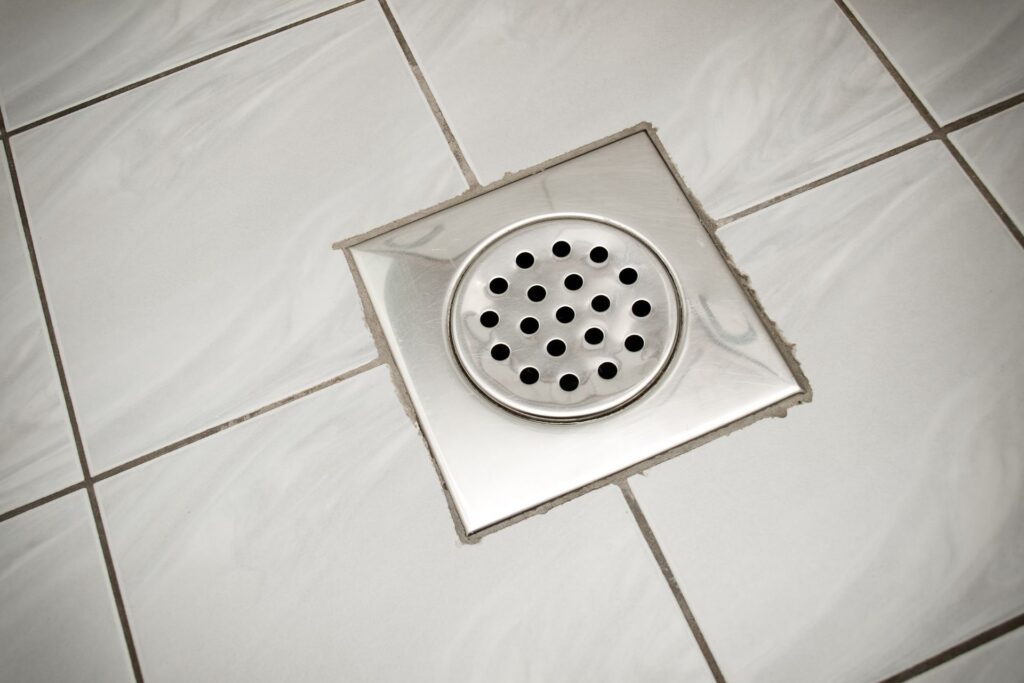
Preparing To Unclog Your Shower Drain
In the vast realm of home maintenance, unclogging a shower drain stands out as a task that, while seemingly simple, requires a good deal of preparation and know-how to execute effectively. Whether you’re a seasoned DIY enthusiast or a first-timer keen on keeping your living space in top condition, This section is here to equip you with all the necessary information for a smooth, hassle-free experience. Let’s dive into the essential steps and tips that will prepare you to tackle this challenge with confidence.
Safety First: Tips and Attire for a Secure Unclogging Process
Before embarking on this plumbing adventure, it’s crucial to prioritize your safety. Dealing with chemicals, water, and potentially sharp objects means taking precautions is non-negotiable. This guide focuses on the safety measures and attire recommendations that will protect you from any unforeseen mishaps.
Gloves: Always wear durable, waterproof gloves. This simple yet effective barrier keeps your hands safe from harmful bacteria and potential irritants found in clogged substances.
Appropriate Clothing: Opt for old, comfortable clothing that you wouldn’t mind getting dirty. Since unclogging a drain can get messy, wearing something protective like an apron or coverall is advisable.
By adhering to these safety protocols, you’re not just ensuring a successful declogging endeavor but also safeguarding your well-being.
Assembling Your Toolkit: Essential Tools and Materials
With safety measures in place, it’s time to gather the tools and materials you’ll need. This section lays out the arsenal required to confront even the most stubborn of clogs, ensuring you’re well-prepared for various scenarios.
Plunger: A plunger can often dislodge clogs with minimal effort. Ensure you have a good-quality plunger that can create a strong seal.
Baking Soda and Vinegar: For a non-chemical approach, the combination of baking soda and vinegar can work wonders in breaking down clogged components.
Plumber’s Snake: For more stubborn blockages, a plumber’s snake, or drain auger, can physically remove clogs that chemical solutions can’t dissolve.
Protective Eyewear (optional): If you’re using chemical drain cleaners, protective eyewear is recommended to prevent accidental splashes in your eyes.
Each tool and material serves a specific purpose, offering a solution tailored to the nature of the clog. By having these items at your disposal, you increase your chances of a successful, efficient unclogging process.
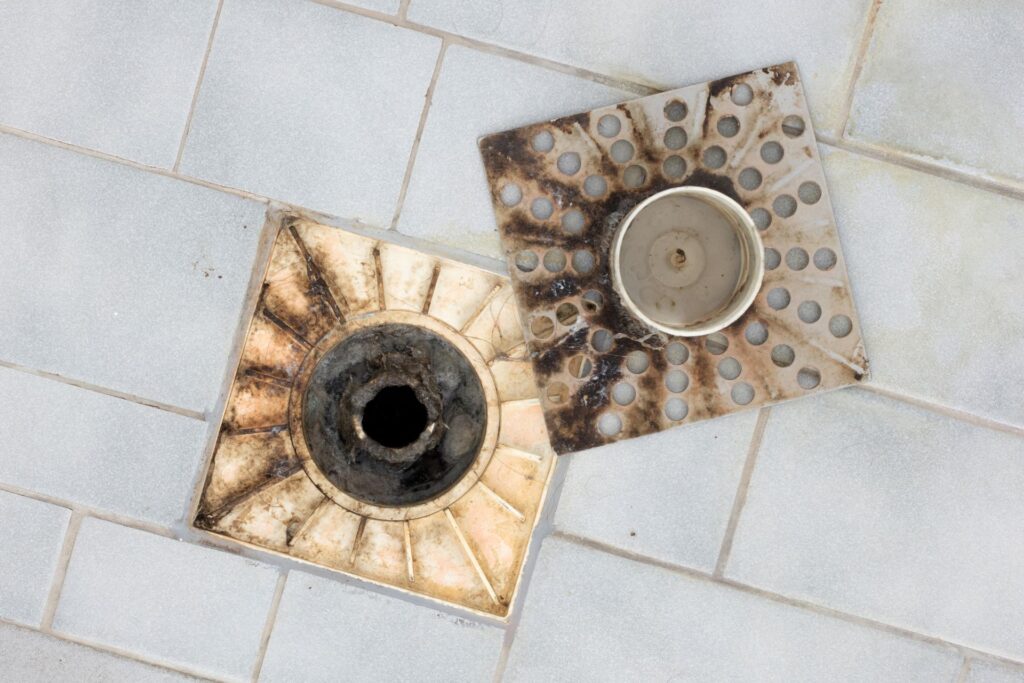
Step-By-Step Guide To Unclogging Your Shower Drain
In today’s fast-paced world, a clogged shower drain is an inconvenience that many of us could do without. Fortunately, with the right knowledge and tools, you can tackle this problem head-on. This comprehensive guide will walk you through various methods to unclog your shower drain, ranging from natural solutions to seeking professional help. By understanding the pros and cons of each approach, you can choose the most effective and safe method for your situation. So, let’s dive into the step-by-step guide to unclogging your shower drain.
Natural Methods: Baking Soda and Vinegar, Boiling Water
Starting with the gentlest options, natural methods are your go-to solution for minor clogs and regular maintenance to prevent future blockages. A popular home remedy involves using baking soda and vinegar. Begin by pouring a cup of baking soda down the drain, followed by a cup of vinegar. The chemical reaction between these two ingredients can help dissolve the gunk and grime that’s causing the blockage. After waiting for about an hour, flush the drain with boiling water to clear out the debris. Speaking of boiling water, it alone can be a simple yet effective method for minor clogs, as the heat helps to melt fats and oils that might be contributing to the clog.
Mechanical Methods: Plunger, Plumber’s Snake
If natural methods don’t do the trick, it’s time to get a bit more hands-on with mechanical tools. A plunger can be used to create suction and pressure that might dislodge the blockage. For best results, cover the overflow drain with a wet cloth to ensure maximum suction and give it several firm plunges. If the clog persists, a plumber’s snake, also known as a drain auger, can be your next step. Carefully feed the snake down the drain until you feel resistance, then rotate it to break apart the clog or hook it to pull it out.
Chemical Cleaners: When to Use Them and Safety Precautions
Chemical drain cleaners offer a powerful solution for tougher clogs, but they should be used as a last resort due to their potential to damage pipes and harm the environment. If you decide to use a chemical cleaner, choose one that is compatible with your plumbing system and follow the instructions carefully. Always use gloves and goggles to protect yourself from harmful fumes and spills.
When to Call a Professional Plumber
Sometimes, despite your best efforts, a clog may prove too stubborn, or you might not feel comfortable using mechanical tools. In such cases, it’s wise to call a professional plumber. Professionals have the experience and equipment to quickly identify and solve complex issues without risking damage to your plumbing.
Tips for Each Method and Common Mistakes to Avoid
For each method, here are some tips and common mistakes to keep in mind:
Natural Methods: Don’t expect immediate results; sometimes, it might take a few tries to see improvement.
Mechanical Methods: Avoid using excessive force with a plumber’s snake, as this could damage your pipes.
Chemical Cleaners: Never mix different cleaners, as this can lead to dangerous chemical reactions.
General Tip: Regularly clean your shower drain cover to prevent hair and soap buildup.
By following this guide, you’re equipped to handle a clogged shower drain with confidence. Remember, regular maintenance is key to preventing future clogs, and when in doubt, seeking professional help is always a prudent choice.
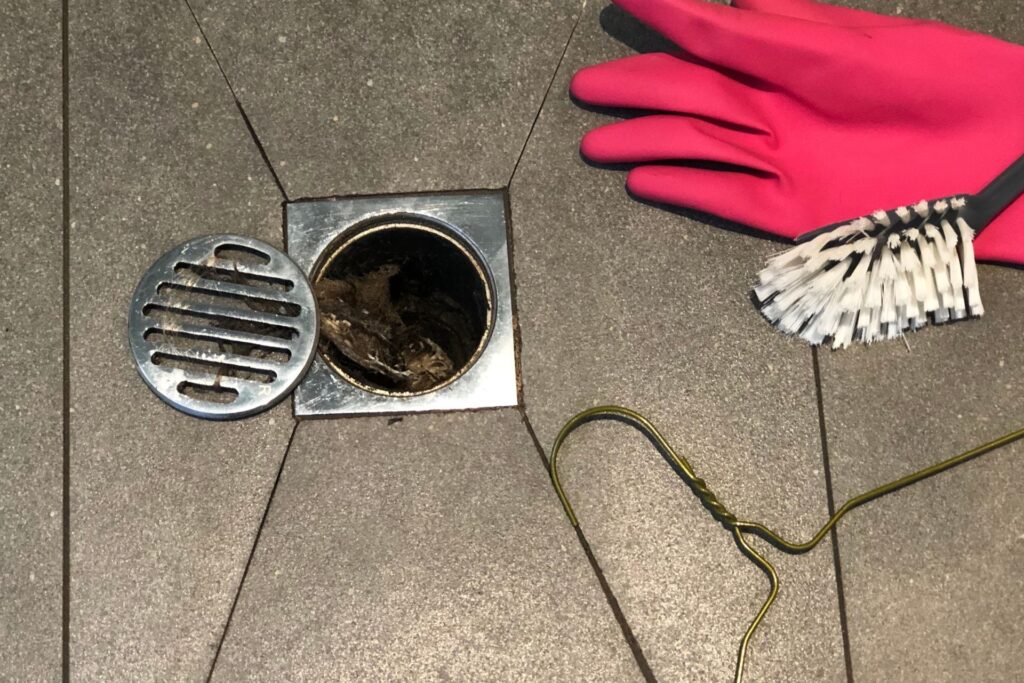
Preventing Future Clogs
Regular Cleaning and Maintenance Tips
Keeping your drains clogged-free is not only a matter of convenience but also essential for the health and longevity of your plumbing system. Regular cleaning and maintenance are key to preventing future clogs. Start with a simple weekly routine of flushing your drains with hot water, which can help dissolve minor build-ups of grease and soap. For a deeper clean, consider using a mixture of vinegar and baking soda. Pour half a cup of baking soda followed by the same amount of vinegar down the drain, let it fizz for a few minutes, then flush with hot water. This natural solution is gentle on pipes and effective at removing build-up.
Additionally, it’s wise to schedule professional drain cleaning services annually. Professionals have the tools and expertise to thoroughly clean and inspect your drains, ensuring they remain in optimal condition and reducing the risk of unexpected clogs.
Recommended Drain Protectors and Filters
Investing in drain protectors and filters can significantly reduce the chances of clogs forming. These simple yet effective tools catch hair, food particles, and other debris before they enter your plumbing system. For kitchen sinks, consider a mesh sink strainer, which can catch food scraps and prevent them from going down the drain. In bathrooms, a silicone hair catcher can be placed over the drain to trap hair effectively. Ensure you clean these protectors regularly to maintain their efficiency.
Lifestyle Changes to Reduce Drain Clogging
Sometimes, the best way to prevent clogs is to adjust our habits. Being mindful of what goes down our drains can make a significant difference. In the kitchen, avoid disposing of grease, coffee grounds, and food scraps in the sink. Instead, dispose of grease in a container throw it in the trash, and consider composting organic waste. In the bathroom, minimize the use of oil-based products in the shower, as they can contribute to build-ups in your pipes.
Moreover, consider using less toilet paper or switching to a quicker-dissolving brand to prevent toilet clogs. Educating household members, especially children, about what should not be flushed down the toilet can also prevent many plumbing issues.
By implementing these tips, you can maintain a clog-free plumbing system, ensuring smooth and efficient drainage in your home. Regular maintenance, the use of protective tools, and mindful lifestyle changes are simple yet powerful ways to prevent future clogs, saving you time, money, and the inconvenience of dealing with blocked drains.

The Environmental Impact Of Drain Cleaners
When it comes to maintaining our homes, few tasks are as universally disliked yet necessary as unclogging drains. Whether you’re faced with a slow sink or a completely blocked shower drain, the instinctive reaction might be to reach for the nearest bottle of drain cleaner. But, have you ever stopped to consider the environmental impact of the chemicals you’re pouring down the drain? In this section, we delve into the complex world of drain cleaners, comparing chemical versus natural solutions, and offering guidance on eco-friendly alternatives. This guide aims to equip you with the knowledge to make more sustainable choices that are kinder to our planet.
Chemical Drain Cleaners: Effective but at What Cost?
Chemical drain cleaners are designed for convenience and effectiveness, offering a quick fix to pesky blockages. They work by causing a chemical reaction that generates heat to dissolve the clog. However, this powerful reaction doesn’t come without significant downsides. The harsh chemicals found in these cleaners can not only damage your plumbing over time, leading to costly repairs but also pose a serious threat to the environment. When these chemicals eventually find their way into rivers, lakes, and oceans, they can harm aquatic life and disrupt ecosystems. Furthermore, the production and disposal of chemical cleaners contribute to pollution and the depletion of natural resources.
The Rise of Natural Cleaners: A Safer Alternative?
In response to growing environmental concerns, many homeowners are turning to natural drain cleaners. These alternatives often utilize ingredients like baking soda, vinegar, and hot water to tackle blockages in a more eco-friendly manner. While they may require a bit more time and elbow grease, they don’t carry the same risks to your plumbing or the environment. Natural cleaners are biodegradable, non-toxic, and safe for both humans and wildlife, making them an excellent choice for those looking to reduce their ecological footprint.
Eco-friendly Alternatives: Beyond Just Cleaning
Adopting eco-friendly alternatives goes beyond simply swapping one product for another. Preventive measures can be equally effective in keeping your drains clear without the need for any cleaners, chemical or natural. Regular maintenance, such as using drain strainers to catch hair and food scraps, can prevent blockages from occurring in the first place. Additionally, for tougher clogs, mechanical methods like plunging or using a drain snake offer a physical solution that eliminates the need for chemicals.
Making the Switch: Advice for Homeowners
Making the switch to eco-friendly drain cleaning methods is not only better for the environment but can also improve the health and safety of your home. Here are a few tips to help you get started:
Start with prevention: Regularly clean your drains using hot water and dish soap to prevent oil and grease build-up.
Use natural solutions: For mild clogs, a combination of baking soda and vinegar can be surprisingly effective.
Consider mechanical options: Invest in a good-quality plunger or a drain snake for the physical removal of clogs.
Educate yourself: Stay informed about the environmental impacts of household products and strive to make more sustainable choices.
In conclusion, the environmental impact of drain cleaners is a significant concern that demands our attention. By understanding the pros and cons of chemical versus natural cleaners and exploring eco-friendly alternatives, we can make choices that protect our planet without compromising on cleanliness. It’s a small but meaningful step towards a more sustainable future.

FAQs: About How To Unblock Shower Drain
Conclusion
Concluding our guide on maintaining a clear and functional shower drain, it’s crucial to reiterate the significance of this often-overlooked aspect of home maintenance. Keeping your shower drain unclogged not only ensures a cleaner and more hygienic bathroom but also prevents the hassle and potential expense of dealing with severe blockages down the line. We’ve walked you through some tried and tested methods to keep those pesky clogs at bay, and we strongly encourage you to give them a go. Whether it’s a simple baking soda and vinegar mixture or a more hands-on approach with a plunger, the satisfaction of a smooth-running drain is undeniable. Now, we’d love to hear from you! Have you tried any of these methods, or do you have any of your tips and tricks to share? Drop your experiences and insights in the comments below. Your contribution not only enriches our community but also helps others in their quest for a clog-free home. Let’s keep the conversation flowing as freely as our drains!
Find A Professional Plumbing Company Near You
- Hot Water Cylinder Installation Auckland
- Hot Water Cylinder Installation Hamilton
- Hot Water Cylinder Installation Wellington
- Hot Water Cylinder Repairs Auckland
- Hot Water Cylinder Repairs Hamilton
- Local Plumbers Auckland
- Local Plumbers Hamilton
- Local Plumbers Whangarei
- Plumbers Wanganui
- Shower Installation Services Auckland
- Shower Installation Services Hamilton
About the Author:
Mike Veail is a recognized digital marketing expert with over 6 years of experience in helping tradespeople and small businesses thrive online. A former quantity surveyor, Mike combines deep industry knowledge with hands-on expertise in SEO and Google Ads. His marketing strategies are tailored to the specific needs of the trades sector, helping businesses increase visibility and generate more leads through proven, ethical methods.
Mike has successfully partnered with numerous companies, establishing a track record of delivering measurable results. His work has been featured across various platforms that showcase his expertise in lead generation and online marketing for the trades sector.
Learn more about Mike's experience and services at https://theleadguy.online or follow him on social media:

